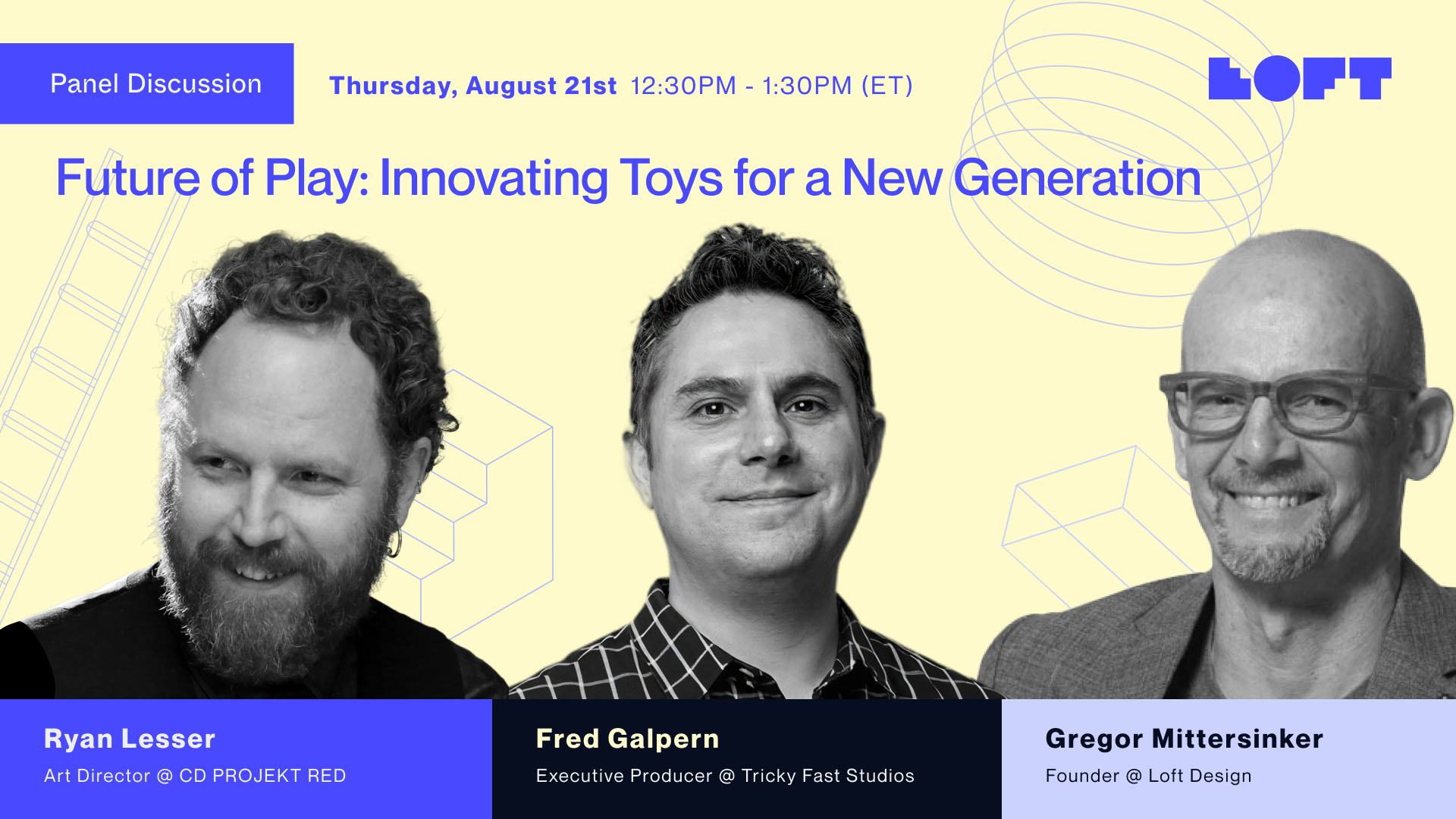By:
Clotilde Grimault
July 30, 2025
When: Thursday, August 21, 12:30 - 1:30 PM EST
Loft Recap: Future of Play Panel
The Loft team recently hosted a lively panel discussion on The Future of Play, exploring the intersection of digital and physical experiences. The conversation stretched from the irresistible glow of screens to the enduring magic of board games, with plenty of insights for both playmakers and product designers.

Today’s toys are no longer just for kids. Adults are driving innovation across design, packaging, and storytelling—transforming play into a rich, multigenerational experience.
Once the centerpiece of childhood, traditional toys have been sidelined by screens. The launch of the iPad and the surge in digital content have reshaped how kids play. Toys now compete with immersive apps and games, making many physical products feel obsolete. As kids flock to virtual worlds, entire categories—such as dolls, board games, and building kits—have declined, leaving once-dominant brands scrambling to stay relevant in a fast-paced, screen-obsessed culture. Childhood is speeding up. Kids now act and think older, thanks to early exposure to tech and social media. The classic toy-buying window, once ages 3–12, is collapsing. Children are aging out by 7 or 8, preferring smartwatches or YouTube to dolls or blocks. For toy companies, this demographic squeeze has raised the stakes—innovation isn’t just about fun anymore; it’s about survival in a drastically shortened timeline of play.
The resurgence of board games among Millennials and Gen Z reflects more than nostalgia—it’s a cultural shift driven by screen fatigue, a need for real connection, and a love of creativity. Raised in a digital world, these generations increasingly seek offline experiences. Board games offer tactile, face-to-face interaction—rolling dice, reading cards, and sharing a table without the distraction of notifications. Far from a childhood pastime, board games have become social anchors, blending storytelling, strategy, and collaboration. Weekly game nights, café meetups, and even livestreamed sessions foster community. The rise of indie creators and crowdfunding platforms like Kickstarter has further fueled the boom, offering players fresh, meaningful games and a chance to support unique voices beyond the mainstream.
Toy innovation is fueled by indie creators and crowdfunding platforms like Kickstarter, which have democratized the industry. This allows unique, niche games to reach audiences beyond traditional retail channels. Millennials especially appreciate supporting small creators and exploring fresh, non-mainstream content. Today’s games often serve as lifestyle items, featuring premium packaging, stunning artwork, and high-quality components that appeal to visually driven Millennials and Gen Z. These details make games collectible, giftable, and worthy of display. Many modern games also combine physical play with digital elements—such as companion apps, augmented reality, or online features—offering a hybrid experience. This blend appeals to tech-native generations who seek meaningful real-world connection alongside digital engagement. Ultimately, this revival reflects a cultural shift toward creativity, connection, and tactile joy.

About the Panelists:
Ryan is an artist, game designer, and musician based in Rhode Island and the Art Director of CD PROJEKT RED’s Project Sirius — a game which combines beloved aspects of The Witcher world with immersive multiplayer gameplay. He has been creating video and board games since 1996, and is perhaps best known for his design and art direction on groundbreaking titles such as Guitar Hero and Rock Band while working as Art Director and Creative Lead at Harmonix. His board games High Heavens and Streets of Steel are also great examples of Ryan’s passion for storytelling and immersive gameplay.
Fred Galpern is a game-industry leader with 25+ years delivering PC, console, mobile, and hardware products generating $100M+ revenue. As Executive Producer and Studio Director, he has built award-winning IP, scaled PuzzleNation from $0 to $2M ARR with a skeleton team, and achieved 50M+ installs. Fred blends creative vision with emerging tech, from AI pipelines to connected peripherals, driving growth, live-ops performance, and player engagement. His leadership unites cross-functional teams, manages P&L, and delivers hit titles for Hasbro, Penny Dell Magazines, and Blue Fang Games, from concept to global launch.
Austrian-born Gregor is in his element while dissecting most complex business & technology challenges and creating their next level business outcomes. Prior to starting Loft, Gregor led a Strategy & Design team at Accenture Interactive, where he helped launch new multi-billion dollar businesses for global fortune 500 companies. He also led creative teams at Rollerblade, InMusic & Cross. He has worked in the US, Europe & Asia over the past 30 years has earned numerous design awards as well as holds well over 100 patents for product innovations around the globe.

Previous
Next

.png)
Innovation